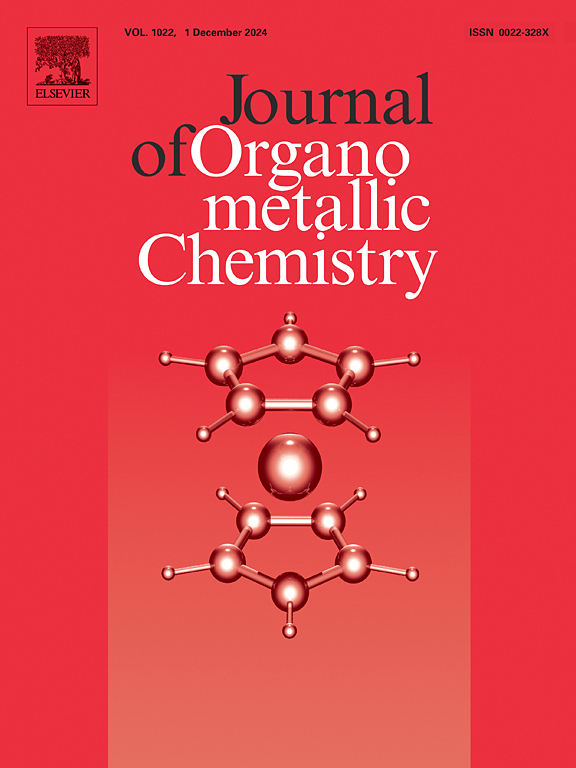可回收氧化石墨烯-二甲双胍- pd(0)纳米催化剂的研制,用于多组分羰基化反应合成喹啉-4(1H)- 1和黄酮
IF 2.1
3区 化学
Q3 CHEMISTRY, INORGANIC & NUCLEAR
引用次数: 0
摘要
在这种方法中,通过将Pd(0)配合物锚定在二甲双胍功能化的氧化石墨烯磁性纳米颗粒上,开发了一种可持续和可重复使用的纳米催化剂GO/MNPs-Met-Pd(0)。通过FT-IR、XRD、VSM、SEM、TEM、TGA、BET、EDX、元素映射、ICP-OES等综合表征,确定了催化剂的结构和组成。考察了氧化石墨烯/MNPs-Met-Pd(0)在两种多组分反应中高效合成喹啉-4(1H)- 1和黄酮衍生物的催化性能。在离子液体介质中进行反应,得到喹啉-4(1H)- 1(15例)的收率为88 - 99%,黄酮(12例)的收率为85 - 98%。该催化剂表现出优异的可重复使用性,在多次循环中活性损失最小。这些结果表明GO/MNPs-Met-Pd(0)是一种高效、选择性和环保的催化剂,可用于可持续合成有价值的杂环支架。与以往报道的羰基化制备喹啉衍生物的方法相比,该方法具有使用高效、可回收、稳定的绿色催化剂,在离子液体中作为绿色溶剂进行羰基化反应,在1 h内合成产物收率很高等突出特点。本文章由计算机程序翻译,如有差异,请以英文原文为准。

Development of a recyclable GO-metformin-Pd(0) nanocatalyst for ecofriendly synthesis of quinoline-4(1H)-ones and flavones via multicomponent-carbonylation reactions
In this method, a sustainable and reusable nanocatalyst, GO/MNPs-Met-Pd(0), was developed by anchoring Pd(0) complexes onto metformin-functionalized graphene oxide-magnetic nanoparticles. Comprehensive characterization using FT-IR, XRD, VSM, SEM, TEM, TGA, BET, EDX, elemental mapping, and ICP-OES confirmed the catalyst’s structure and composition. The catalytic performance of GO/MNPs-Met-Pd(0) was evaluated in two multicomponent reactions for the efficient synthesis of quinoline-4(1H)-one and flavone derivatives. Conducted in ionic liquid media, the reactions yielded quinoline-4(1H)-ones (15 examples) with 88–99 % yields and flavones (12 examples) with 85–98 % yields. The catalyst demonstrated excellent reusability with minimal activity loss over multiple cycles. These results highlight GO/MNPs-Met-Pd(0) as a highly efficient, selective, and eco-friendly catalyst for the sustainable synthesis of valuable heterocyclic scaffolds. Compared to previously reported methods for preparing quinoline derivatives via carbonylation reactions, this method has prominent features such as the following: use of a green catalyst with high efficiency, recyclability, and stability, carrying out carbonylation reactions in an ionic liquid as a green solvent, and synthesis of products with very high yields in 1 h.
求助全文
通过发布文献求助,成功后即可免费获取论文全文。
去求助
来源期刊

Journal of Organometallic Chemistry
化学-无机化学与核化学
CiteScore
4.40
自引率
8.70%
发文量
221
审稿时长
36 days
期刊介绍:
The Journal of Organometallic Chemistry targets original papers dealing with theoretical aspects, structural chemistry, synthesis, physical and chemical properties (including reaction mechanisms), and practical applications of organometallic compounds.
Organometallic compounds are defined as compounds that contain metal - carbon bonds. The term metal includes all alkali and alkaline earth metals, all transition metals and the lanthanides and actinides in the Periodic Table. Metalloids including the elements in Group 13 and the heavier members of the Groups 14 - 16 are also included. The term chemistry includes syntheses, characterizations and reaction chemistry of all such compounds. Research reports based on use of organometallic complexes in bioorganometallic chemistry, medicine, material sciences, homogeneous catalysis and energy conversion are also welcome.
The scope of the journal has been enlarged to encompass important research on organometallic complexes in bioorganometallic chemistry and material sciences, and of heavier main group elements in organometallic chemistry. The journal also publishes review articles, short communications and notes.
 求助内容:
求助内容: 应助结果提醒方式:
应助结果提醒方式:


